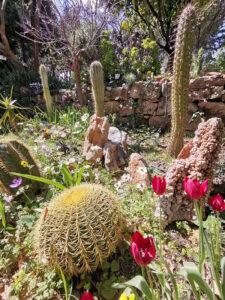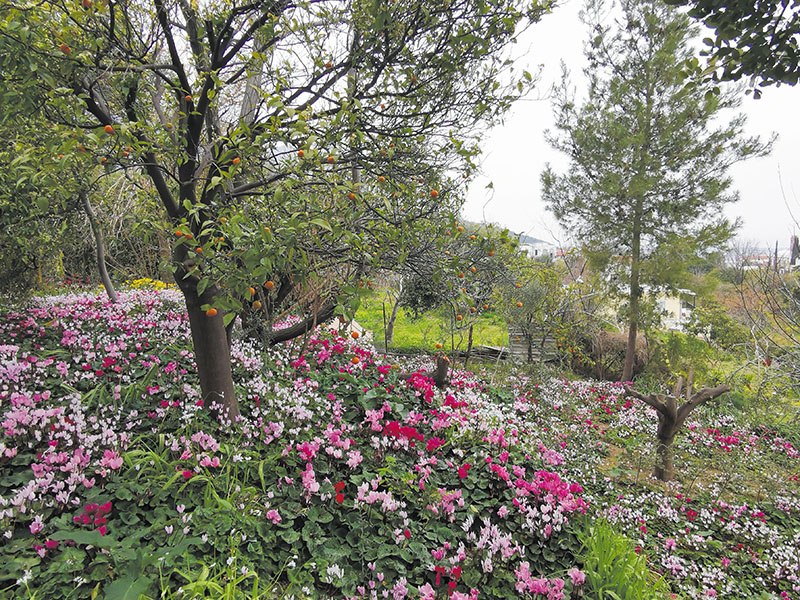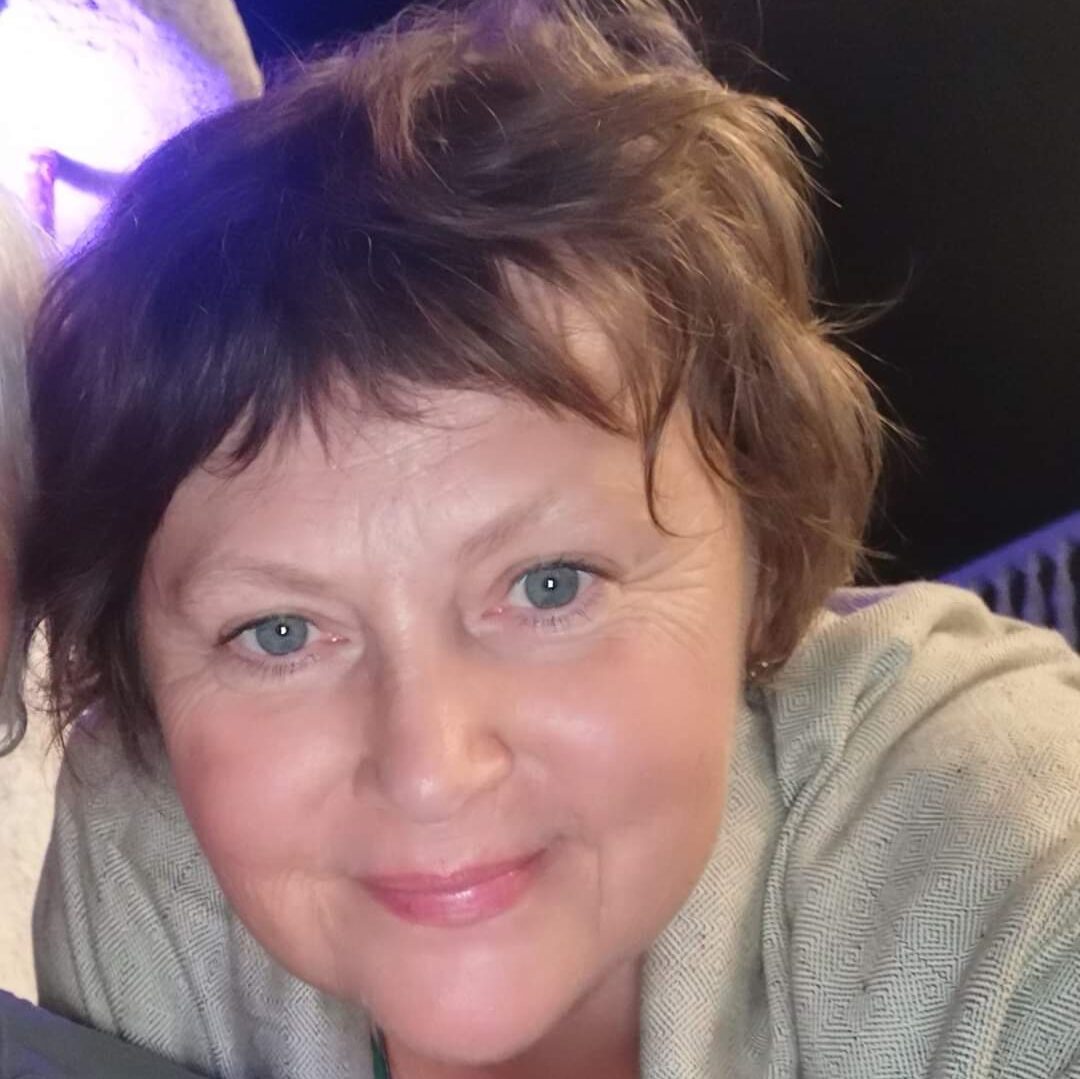Working alone with Mother Nature, a gardener in Lapithos has made a backyard to marvel at with endemic plants providing a riot of colour. AGNIESZKA RAKOCZY has a look around
Thousands of cyclamens, tulips and anemones welcome visitors to one of the island’s stand-out gardens, the collaborative creation of Mother Nature and the loving hands of Hikmet Ulucam, the well-known Turkish Cypriot graphic designer.
Located on the slopes of the Pentadaktylos, that on the day I stopped by overlooked a shining sparkling sea below, this garden is home to more than 70 kinds of flowers, most of them endemic, 16 types of wild orchids, 500 different types of cacti, 22 species of forest trees and 22 varieties of fruit trees.
“This year there are more than 15,000 Tulipa Cypria in my garden, 10,000 cacti and literally trillions of cyclamens,” the 72-year-old, originally from the village of Marona in Troodos, says with a quiet pride.

Ulucam was born in Marona in the Dharizos valley, 24 kilometres east of Paphos, in 1950. His father Sadiq, a farmer, became the mukhtar of Marona in the year of Ulacam’s birth, a position he took over from his father-in-law.
“My father was well-educated. As a child he was sent to Nicosia to study in the Turkish lycee where he was taught how to speak English and Greek and how to read old Ottoman script. Imagine what it must have been like in those days to come from such a small village to study in Nicosia? I still have his old mukhtar register book. The first birth recorded in this book is my own,” says Ulucam
The village was almost entirely Turkish Cypriot, although a couple of Greek Cypriot families owned some land in the area. It was also once the second biggest Maronite village in Cyprus, which was how it acquired its name, Ulucam says.
Ulucam’s father enjoyed good relations with the Greek Cypriots in the neighbouring villages. “Everybody knew him. There was never a conflict there. Even after the war, for the next several months my parents still lived in the village and he still used to go to the neighbouring Greek Cypriot villages to sell his products. But one day one of his best Greek Cypriot friends stopped him on his way back and told him: ‘Mukhtari, please don’t misunderstand me but please don’t come here any more. I heard some of our youth talking about you and I really don’t want them to kill you.’ Then he stopped going.”
According to folklore, the story goes that there was also a saint in the village called Ayios Marona who helped poor people. “Apparently, there was a saying in the old days that if you were poor you should go to Marona because the saint there would help you.”
Currently, the village is abandoned save for some goats. Ulucam visits from time to time.
In 1974 Ulucam was in Istanbul studying graphic design at Istanbul Fine Arts Academy (currently Mimar Sinan Fine Arts University). Originally he wanted to study painting, in part because it was his father’s dream (“I liked painting and drawing and he always said ‘my son will be an artist’)”. However, when he first came to Istanbul to register for his studies, he discovered that the painting department had enrolled five other Turkish Cypriots ahead of him. “The lady in charge of registration told me to choose something else.”
Ulucam, being shy and unsure as to what he should do faced with such an ultimatum, took her at her word and opted for graphic design.
“For the first five or six months, I was very unhappy with my choice but then I realised that as a graphic designer I would be able to start earning money much earlier than if I was a painter. And I needed money. So afterwards I was very happy.”

“I only got a message through the Red Cross that they were ok.”
Gradually, members of his family started making their way northwards. Leading the way was his brother-in-law, a policeman, prioritised under the exchange scheme initiated by the two sides. Eventually, both his sisters, his brother and then finally his parents were brought over with a UN convoy.
“The villagers from Marona were offered a move to Ayios Nicolaos east of Kyrenia. My father went there but he was used to living next to the river and he found the new location too dry. Instead, because he had also had some land in Malia he decided it was better to go to the village where the people from Malia had settled and this was Prastio, west of Morphou,” Ulucam explains.
He himself was still in Istanbul at this time, working for an advertising company. When he did finally return to Cyprus in the early 1980s he decided to settled in Lapithos, which was where one of his sisters was living. It also appealed to him because his best friend artist Emin Cizenel lived nearby. Initially Ulucam lived with his sister’s family but after a while, he decided to look for his own place.
“I had some exchange points because of the properties the family had left in the south [the system used in the north for the distribution of Greek Cypriot properties to Turkish Cypriots who moved to the north] so I decided to use them. I wanted an old house and after some searching I found this one. It was completely derelict and there was no garden around it but the view was spectacular. I applied for it in 1982.”
I ask if he knows who lived in the house before 1974 and he says that as far as he knows it was used as a holiday rental.
“What I also heard was that during the Second World War it was rented to a teacher from the Turkish lycee in Nicosia because the British government at that time evacuated the school to Kyrenia. The teacher and two students were living here. And somebody once told me that later King Farouk used to rent this place but I don’t have any confirmation of this story. Also, apparently even earlier, there was a kiln in the garden and Lapithos pottery was produced here. This is fascinating since I also have a kiln here and I used to make Lapithos ceramics in the past.”
Ulucam set about renovating the house, got married and had a son. He worked on various projects: designed posters for cultural events (reflecting his commitment to “stay with my profession”), taught Turkish Cypriot children how to make Lapithos pottery (“a bi-communal project run by the UNDP”), and designed stamps (“I designed 42 stamps that travelled on envelopes from the north all over the world”). He also got employed as a graphic designer in Kibris newspaper and lectured at a university. And for all the time, he was working in the garden that surrounds the house.
“The first tree I planted was a great pine tree that in the Turkish language is called Ulucam, our family surname. The derivation goes back to 1958 when our village Marona changed its name in Turkish to Ulucam and my father took on this as our surname. As you can see, there is a great pine tree at the entry to the garden now.”
After the trees, Ulucam focused on the cacti that he had loved for their interesting shapes. And then he turned his attention to the wild flowers. “Slowly I started growing them as well. You know, I am a Capricorn and, according to the horoscope, Capricorns are good with soil and I believe in such things,” he confesses.
“In Marona, during summer holidays, I always worked as a shepherd. My father had 150 sheep and I would take them to the fields. I was spending all the days in the fields and I was observing plants, flowers, trees… I also watched my father at work, how he grafted on bitter oranges and I started doing the same.”
Indeed Ulucam must have very green fingers. It seems that whatever plant he turns his attention to blossoms happily. “They know that I love them and that is why they are happy here”.
His dream is to gather in his garden all the rare endemic plants that can be found in Cyprus. He comes across them during his walks, makes a point of remembering where they grow, and then goes back at the appropriate time to collect their seeds, which he then plants. But, he does more than that. He also takes the seeds of the rare plants that he nurtures in his garden and plants them in other places where he knows they will flourish and do well. He does the same with trees, not just planting them where he feels they are needed but also grafting on some of them to change them into rarer cousins.
Divorced now – he admits that his wife used to complain that he spent too much time in the garden – Ulucam’s life in great measure focuses on plants. In winter, when it is not raining, he spends up to two hours each morning weeding. “It is great for my physical condition”.
In the summer, once the flowers fade and die, he weeds again and then begins the backbreaking work of seed collection. Summer also provides him with the welcome chance for a pre-breakfast swim. Then, before the full heat of midday strikes he starts watering his cacti, taking a short afternoon siesta before resuming. “With the number of cacti I have, I practically water all the time since each cactus needs a good drink at least once a week.”
His break comes at the beginning and end of the summer season, when the garden isn’t so demanding and he can take a week off.
So what is his dream, to ensure that this piece of paradise will never be lost? What does the future hold for this centerpiece of his life’s work?
“I started opening the garden to the public for three weeks every spring seven years ago and now it is an extremely popular calendar event for Cypriots and foreigners from both sides.” He takes great pride that more and more people visiting the garden a making a “pilgrimage” from north and south.
“On Sunday, there were more than 300 people. My dream is to create a lovely botanical garden before I die. However the problem is I am all alone and this is so much work and I am not getting any help from anybody. Every year I send invitations to politicians asking them to come and see what I am doing here but they never appear. They don’t seem to know where this place is. I have invited our mayor several times but he hasn’t come. What can I say? It appears that they just don’t care.”
The authorities may be indifferent or even ignorant of this retreat but they can be assured that as long as Ulucam flourishes he will continue his artistic collaboration with Mother Nature and those who come to visit will marvel at his beautiful work.







Click here to change your cookie preferences